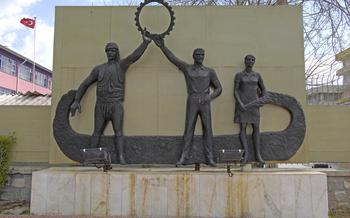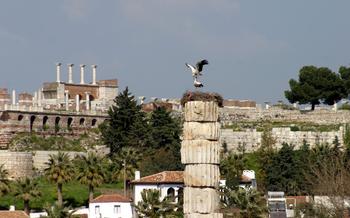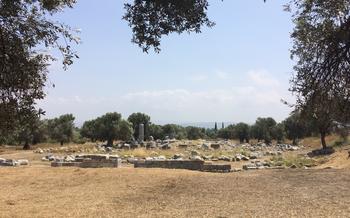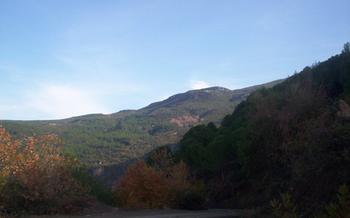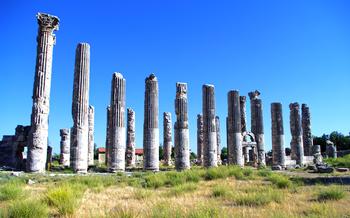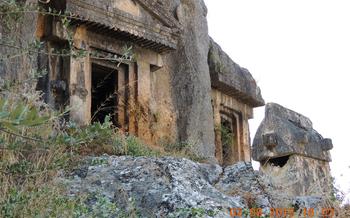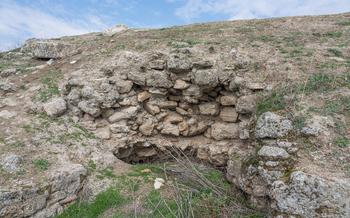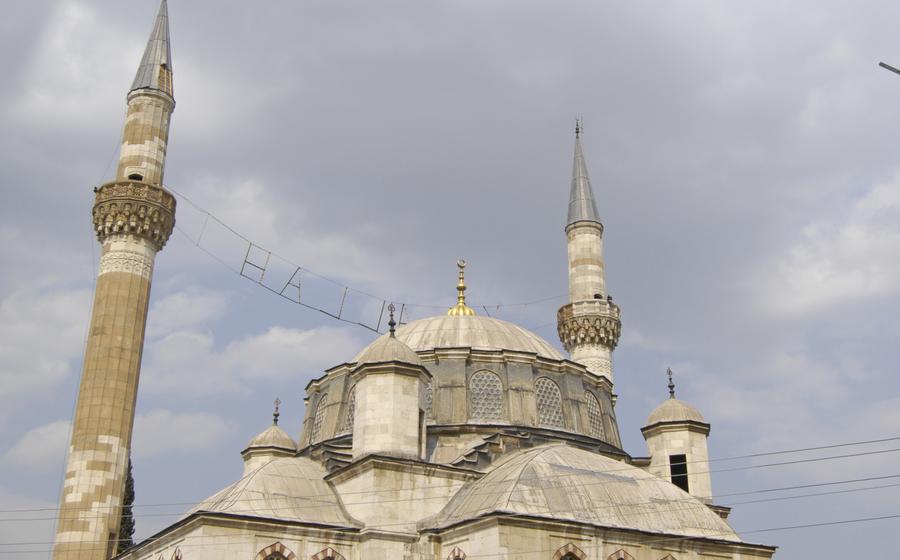
The Ancient City of Magnesia on the Meander
- A Journey to Magnesia on the Meander
- Unveiling Magnesia's Storied Past
- Exploring the Ruins of Magnesia
- Magnesia's Enduring Legacy:
- The Temple of Artemis Leucophryene
- Magnesia's Ancient Theater
- The Agora: Marketplace and Meeting Place
- The Necropolis: City of the Dead
- The Meander River: A Natural Wonder
- Local Cuisine: A Culinary Journey
- Magnesia's Festivals and Events: A Celebration of Culture and Tradition
- Accommodation and Amenities:
- Insider Tip: Hidden Gems
A Journey to Magnesia on the Meander
Magnesia on the Meander, an ancient city nestled in the picturesque region of Manisa, Turkey, beckons travelers with its rich history, awe-inspiring ruins, and stunning natural beauty. Once a flourishing center of trade and culture, Magnesia offers a captivating glimpse into the grandeur of the ancient world.
Strategically located at the crossroads of ancient trade routes, Magnesia served as a vital link between the Aegean coast and the Anatolian hinterland. Its proximity to major cities like Izmir and Manisa makes it easily accessible for modern-day travelers seeking an unforgettable journey through time.
The best time to visit Magnesia is during the shoulder seasons, spring (April-May) and autumn (September-October), when the weather is pleasant and the crowds are smaller. Summer months can be hot and dry, while winters can be chilly and wet, affecting the overall exploration experience.
Unveiling Magnesia's Storied Past
Archaeological excavations conducted at the site of Magnesia on the Meander have unearthed a wealth of artifacts and ruins, shedding light on the city's rich history and significance. These excavations have revealed the remains of temples, theaters, public buildings, and residential areas, providing valuable insights into the city's urban planning and daily life.
Magnesia played a crucial role in ancient trade routes, serving as a hub for the exchange of goods and ideas between Anatolia, the Aegean coast, and the Mediterranean region. Its strategic location on the fertile plains of the Meander River made it a prosperous center for agriculture and commerce.
Throughout its history, Magnesia witnessed a succession of powerful rulers and empires, each leaving their mark on the city's development. From the Persian Achaemenid Empire to the Hellenistic Seleucids and the Roman Republic, Magnesia experienced a blend of cultural influences that shaped its architecture, art, and religious practices.
The city's name, Magnesia, is believed to be derived from the ancient Lydian word "Magna," meaning "mother goddess." This reflects the city's strong ties to the worship of Artemis, the Greek goddess associated with fertility and nature. The Temple of Artemis Leucophryene, one of the most impressive structures in Magnesia, was dedicated to this goddess and served as a major religious center for the region.
Exploring the Ruins of Magnesia
The ancient city of Magnesia on the Meander is a treasure trove of well-preserved ruins, offering a glimpse into the architectural prowess and artistry of its past inhabitants. Among the most notable structures are the Temple of Artemis Leucophryene, the Ancient Theater, the Agora, and the Gymnasium and Baths.
-
Temples: The Temple of Artemis Leucophryene, dedicated to the goddess Artemis, is the most prominent temple in Magnesia. Known for its Ionic columns and intricate carvings, it once housed a colossal statue of Artemis that was considered one of the Seven Wonders of the Ancient World. Other temples found at the site include the Temple of Zeus and the Temple of Apollo.
-
Theaters: Magnesia's ancient theater is a marvel of acoustic engineering. With a seating capacity of over 15,000 spectators, it hosted theatrical performances, musical concerts, and civic assemblies. The theater's well-preserved stage and orchestra pit provide a glimpse into the vibrant cultural life of ancient Magnesia.
-
Agora: The agora, or marketplace, was the bustling heart of the ancient city. Surrounded by shops, stalls, and public buildings, it served as a center for trade, commerce, and social interaction. The agora's well-preserved colonnades, fountains, and altars offer a glimpse into the daily lives of Magnesia's inhabitants.
-
Gymnasium and Baths: The gymnasium and baths were essential facilities for physical training and relaxation in ancient Magnesia. The gymnasium, with its palestra, running track, and wrestling area, provided a space for athletes to train and compete. The baths, with their hot and cold pools, steam rooms, and massage areas, offered a place for citizens to socialize and rejuvenate.
Magnesia's Enduring Legacy:
Magnesia's influence extended far beyond its city walls, leaving an indelible mark on the cultural and intellectual landscape of the ancient world.
-
Cultural Influence: Magnesia's vibrant culture influenced neighboring regions, particularly in the areas of art, architecture, and philosophy. Its unique blend of Greek, Persian, and Anatolian influences produced a rich and diverse cultural heritage.
-
Contributions to Art and Architecture: Magnesia's artisans and architects created stunning works of art and architecture that showcased their exceptional skills and creativity. The city's temples, theaters, and public buildings were renowned for their grandeur and beauty, inspiring awe and admiration.
-
Spread of Hellenistic Culture: Magnesia played a pivotal role in disseminating Hellenistic culture throughout Anatolia. As a major center of learning and scholarship, it attracted scholars, philosophers, and artists from across the region, who exchanged ideas and shared knowledge.
-
Preservation and Research: Today, Magnesia's legacy continues to be preserved and studied by archaeologists, historians, and scholars. Ongoing research and excavations at the site are shedding new light on the city's rich past and its enduring impact on the ancient world.
The Temple of Artemis Leucophryene
The Temple of Artemis Leucophryene, dedicated to the Greek goddess of hunting and nature, was the most prominent religious and cultural center in Magnesia on the Meander. Constructed in the 3rd century BC, the temple's grand Ionic columns and intricate sculptures reflected the city's wealth and artistic prowess. Its unique feature was the presence of two cult statues of Artemis, one representing the Greek goddess and the other a local Anatolian deity. The temple's strategic location atop a hill allowed it to serve as a beacon for sailors navigating the Meander River and a symbol of Magnesia's power and influence throughout the region. Despite its partial destruction over time, the temple's enduring legacy remains a testament to Magnesia's rich cultural heritage and its deep connection to the divine.
Magnesia's Ancient Theater
The ancient theater of Magnesia on the Meander is a remarkable testament to the city's vibrant cultural and civic life. Constructed in the 2nd century BC, this magnificent structure could accommodate up to 15,000 spectators, making it one of the largest theaters in the ancient world.
The theater's impressive dimensions and architectural features reflect the importance of the performing arts in ancient Magnesia. The stage building, adorned with intricate carvings and sculptures, provided a grand backdrop for theatrical performances, musical concerts, and other public events.
The theater's acoustics are particularly noteworthy, allowing the voices of performers to carry clearly throughout the auditorium. This remarkable acoustic engineering ensured that even those seated in the uppermost rows could fully experience the performances.
In ancient times, the theater served as a central gathering place for citizens of Magnesia and visitors from across the region. It hosted a variety of performances, including Greek tragedies and comedies, as well as musical and dance recitals.
Today, the theater stands as a testament to the enduring legacy of Magnesia. While it is no longer used for its original purpose, it remains an impressive and evocative monument to the city's rich cultural heritage. Restoration efforts are underway to preserve and restore the theater, ensuring that it continues to captivate visitors for generations to come.
The Agora: Marketplace and Meeting Place
The agora, the bustling heart of ancient Magnesia, served as a vibrant center for trade, social interaction, and civic life. This sprawling marketplace was a hive of activity, where merchants from across the region gathered to buy and sell goods, farmers brought their produce, and citizens mingled to exchange news and ideas.
The agora's layout was carefully planned, with colonnaded walkways lining its perimeter, providing shade and shelter to shoppers and traders. Within these colonnades, merchants displayed their wares in small shops and stalls, offering everything from exotic spices and fine fabrics to locally produced pottery and agricultural goods.
Beyond the commercial realm, the agora also served as a crucial meeting place for the community. Citizens gathered here to discuss politics, attend civic assemblies, and participate in religious ceremonies. The agora was also home to important public buildings, such as the bouleuterion (council chamber) and the prytaneion (government building), further emphasizing its role as the city's administrative center.
Archaeological excavations at the agora have uncovered a wealth of artifacts that shed light on daily life in ancient Magnesia. These finds include coins, pottery fragments, inscriptions, and even weights and measures used in trade. Together, these artifacts provide a glimpse into the economic, social, and political dynamics that shaped this ancient city.
The Necropolis: City of the Dead
Magnesia's necropolis, or ancient cemetery, is a vast and evocative site that offers a glimpse into the city's funerary customs and beliefs. Located just outside the city walls, the necropolis contains a diverse array of tombs and burial structures, ranging from simple graves to elaborate mausoleums.
The most common type of tomb in Magnesia is the rock-cut tomb, which was carved directly into the soft limestone bedrock. These tombs typically consist of a single chamber, with a raised platform or bench where the deceased was laid to rest. Some rock-cut tombs are decorated with simple geometric patterns or inscriptions, while others feature more elaborate carvings and sculptures.
In addition to rock-cut tombs, the necropolis also contains a number of built tombs, which were constructed using stone blocks. These tombs are often larger and more elaborate than the rock-cut tombs, and they may contain multiple chambers and niches for burials. Some built tombs are decorated with elaborate facades and columns, and they may even have inscriptions that provide information about the deceased and their family.
The necropolis is a valuable source of information about Magnesia's social and cultural history. The tombs and burial practices provide insights into the city's religious beliefs, social stratification, and artistic traditions. The necropolis is also a reminder of the city's long and rich history, as it contains burials from the Hellenistic, Roman, and Byzantine periods.
Among the most notable tombs in the necropolis is the Tomb of the Lion, which dates back to the 4th century BC. This impressive tomb is carved into the side of a hill and features a large lion sculpture at its entrance. The tomb is thought to have belonged to a wealthy and powerful family, and it is one of the best-preserved tombs in the necropolis.
Another notable tomb is the Tomb of the Musicians, which dates back to the 2nd century AD. This tomb is decorated with a series of reliefs depicting musicians playing various instruments. The reliefs are finely carved and provide a valuable glimpse into the musical traditions of ancient Magnesia.
The Meander River: A Natural Wonder
The Meander River, with its graceful bends and meanders, is an integral part of Magnesia's history and landscape. This natural wonder, known for its unique geographic formations, has played a significant role in shaping the city's development. Take a leisurely stroll along the picturesque riverbanks, immersing yourself in the serene beauty of the surroundings. Enjoy a delightful picnic amidst the lush greenery, as the gentle breeze carries the sweet melodies of birdsong. Discover local legends and myths associated with the Meander River, adding a touch of enchantment to your visit.
Local Cuisine: A Culinary Journey
Indulge in the culinary delights of Magnesia, where traditional Turkish cuisine blends with the region's unique flavors. Savor the aromatic Manisa kebab, a tender skewer of marinated meat grilled to perfection. Don't miss keşkek, a hearty dish made from pounded wheat, meat, and spices, a local specialty. For a refreshing treat, try üzüm hoşafı, a sweet and tangy grape juice.
Explore the vibrant local markets, where you can find fresh produce, spices, and handmade delicacies. Engage with friendly vendors and learn about the region's culinary traditions. Whether you prefer a casual meal at a family-run eatery or a fine dining experience in a charming restaurant, Magnesia offers a diverse range of culinary experiences.
Embrace the opportunity to savor the local cuisine and immerse yourself in the rich cultural heritage of this ancient city.
Magnesia's Festivals and Events: A Celebration of Culture and Tradition
Magnesia, with its rich history and vibrant culture, is a city that comes alive during its annual festivals and events. These celebrations offer a unique opportunity to immerse yourself in the local traditions and customs, and experience the warm hospitality of the Turkish people.
One of the most popular events is the Magnesia International Music Festival, held every summer. The festival features a diverse lineup of local and international musicians, showcasing a range of genres from classical to contemporary. With concerts held in historic venues throughout the city, the festival attracts music lovers from all over the region.
Another highlight is the Magnesia Grape Harvest Festival, held in September to celebrate the region's renowned viticulture. Visitors can join in the grape picking, sample local wines, and enjoy traditional Turkish music and dance performances.
For a glimpse into Magnesia's past, don't miss the annual Roman Games festival. This three-day event features gladiator battles, chariot races, and other historical reenactments, providing a thrilling and educational experience for visitors of all ages.
To fully immerse yourself in the local culture, be sure to attend one of the many religious festivals held throughout the year. These festivals, which often involve processions, music, and dancing, offer a chance to witness the deep faith and devotion of the Turkish people.
When planning your visit to Magnesia, be sure to check the local calendar for upcoming festivals and events. These celebrations are a fantastic way to experience the city's vibrant spirit and create lasting memories of your time in Turkey.
Accommodation and Amenities:
Magnesia offers a range of accommodation options to suit every traveler's needs and budget. From budget guesthouses and hostels to mid-range hotels and luxurious resorts, there's something for everyone. For a truly immersive experience, consider staying in a traditional Ottoman-style guesthouse, where you can soak in the city's history and charm.
When choosing a hotel, consider factors such as location, amenities, and proximity to the city's main attractions. For easy access to the ancient ruins and the city center, opt for a hotel in the heart of Magnesia. Many hotels offer stunning views of the Meander River and the surrounding mountains, adding an extra touch of magic to your stay.
In terms of amenities, most hotels provide modern conveniences such as air conditioning, Wi-Fi, and private bathrooms. Some hotels also feature swimming pools, fitness centers, and spa facilities, allowing you to relax and rejuvenate after a day of exploring.
To ensure a comfortable and hassle-free stay, it's advisable to book your accommodation in advance, especially during peak tourist season. Online booking platforms and travel agents can help you find the best deals and compare prices across different hotels.
Insider Tip: Hidden Gems
Beyond the well-known ruins and attractions, Magnesia holds a treasure trove of hidden gems waiting to be discovered by curious travelers. Venture off the beaten path to uncover lesser-known ruins, such as the Temple of Apollo, located on a hilltop overlooking the Meander River, or the ancient quarry, where you can witness the remnants of Magnesia's once-thriving stone industry.
Seek out the scenic viewpoints that offer breathtaking panoramas of the city and the surrounding countryside. Hike to the top of Mount Sipylus, the legendary home of the sleeping giant, to witness a mesmerizing sunrise or sunset. Stroll along the banks of the Meander River, where you can admire the tranquil beauty of nature and spot diverse bird species.
Immerse yourself in the local culture by visiting the traditional markets, where you can haggle for fresh produce, handmade crafts, and unique souvenirs. Engage with the friendly locals, who are always eager to share stories about their city's rich history and traditions. Remember to approach these interactions with respect and curiosity, observing local customs and etiquette to ensure a positive and enriching experience.
